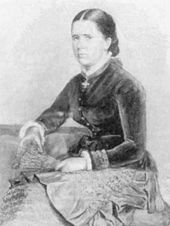Kröcher (noble family)
Kröcher (also Kroecher or Kröchern ) is the name of an old noble family from the ore monastery of Magdeburg . Cröchern , the ancestral home of the family, is now part of the Burgstall community in the Börde district in Saxony-Anhalt . The family name changed between Cröchern, Krocher, Krocker, Kröcker and Kröcher. Branches of the family still exist today.
history
The Lords of Kröcher belonged to the archmagdeburg nobility, they also settled in the Mark Brandenburg early on. They shared their rare coat of arms , the camel or dromedary , with the von Olvenstedt family, who were also from Erzmagdeburg and appear at the same time . There was probably a tribal community between the two families.
The Kröcher first appeared in a document in 1184 with Radobo de Crochere and in 1189 and 1197 their ancestors Marquardus and Albertus de Olvenstede . While the Olvenstedt went out at the end of the 14th century, the Lords of Kröcher were able to stay permanently in the Mark Brandenburg.
In the 70s and 80s of the 13th century, Johann von Kröcher worked at the court of the Brandenburg margraves . His son Johann , called Droiseke, mentioned in a document from 1281 to 1321, came into an influential position and became the most important representative of the family around 1300. Droiseke acquired the castles of Beetzendorf and Calbe with 21 villages in 1296 . He was so wealthy that he and his relatives could lend the sovereigns enormous sums of money. For this loan , the Kröcher received goods in the Prignitz , including 1336 Roddahn and 1337 Lohm (today part of Zernitz-Lohm ) and in the same year Dreetz in the Ruppin rule . The Altmark Beetzendorf passed to the von der Schulenburg in 1343 ; Dreez was divided several times, the last part exchanged for Blankenberg in 1774 , Lohm also divided.
In the middle of the 15th century the sex split into two main lines. The older one became extinct in the first half of the 18th century, the younger branched further into four large branches in the 16th century. The second branch on Vinzelberg (since 1816) and Lohm II and the fourth branch on Lohm I and Babe (today part of Roddahn ) in Ostprignitz are still in flower today.
Important members of recent times were the Real Secret Council Jordan von Kröcher auf Vinzelberg (* 1846, † 1918), President of the Prussian House of Representatives from 1898 to 1911, and Bertha von Kröcher (* 1857; † 1922), a social reformer and founder of the Conservative Association Women. In 1924 Hans Adolph Bernhard von Kröcher sold the Lohm II estate with a size of 953 hectares and emigrated to America; his mother and sister lived in a cavalier house until after 1945. Vinzelberg was expropriated in 1945.
Vinzelberg Castle , Altmark
Lohm II Castle , Ostprignitz
coat of arms
Family coat of arms
The coat of arms shows a striding, silver camel in blue . The camel is growing on the helmet with the blue-silver helmet covers .
Older coats of arms depict a dromedary instead of a camel.
Heraldic saga
According to the legend, two Kröcher brothers once met a Saracen crowd in the promised land who were carrying a captured Christian woman on a richly laden camel. They had bravely attacked the numerous enemies and snatched the Christian woman and her treasures from them, brought her back home and added the camel to her coat of arms to commemorate that day.
Name bearer
- Georg Volrath von Kröcher (* 1678, † 1748), Prussian lieutenant general, governor of Stettin and Jasenitz and heir to Löhme and Metzelthin
- Wilhelm von Kröcher (* 1782; † 1861), manor owner, district administrator and regional director of the Altmark
- Friedrich Wilhelm von Kröcher (* 1810; † 1891), German manor owner and administrative officer
- August von Kröcher (* 1817; † 1869), Prussian civil servant, genealogist and from 1863 to 1869 member of the Prussian manor house
- Adolf von Kröcher (* 1846; † 1922), Prussian lieutenant general
- Jordan von Kröcher (* 1846, † 1918), Real Privy Councilor and President of the Prussian House of Representatives
- Bertha von Kröcher (* 1857; † 1922), social reformer and founder of the Association of Conservative Women
- Rabod von Kröcher (* 1880 - † 1945), German show jumper and silver medalist at the 1912 Olympic Games
- Britta von Kröcher (* 1942), German painter and wax batik artist
- Udo von Kröcher , President of the Bundessortenamt
- Kai von Kröcher (* 1964), German photographer and journalist
literature
- Heinrich Graesse: German aristocratic history. (Reprint of the 1876 edition) Reprint-Verlag, Leipzig 1999; ISBN 3-8262-0704-1 .
- Otto Hupp : Munich Calendar 1927 . Book u. Art Print AG, Munich / Regensburg 1927.
- Genealogical manual of the nobility , Adelslexikon Volume VII, Volume 97 of the complete series, CA Starke Verlag, Limburg (Lahn) 1989, ISSN 0435-2408
- August Henning von Kröcher: History of the family von Kröcher . Berlin. Vol. 1: Twelfth to fifteenth centuries . (1865), Vol. 2: 15th to 19th century (1864)
- August Henning von Kröcher: Document book on the history of the family of Kröcher . Berlin. Vol. 1: 1184 - 1440 (1865), Vol. 2: Fifteenth to nineteenth centuries (1864) Part 2
- August Henning von Kröcher: Appendix to the history of the family von Kröcher . Berlin, 1868
- Kröcher coat of arms in Siebmacher's coat of arms book from 1605
- Crook . In: New general German nobility lexicon
- Crook . In: New Prussian Adelslexicon
- Coat of arms seal from 1274 with description (page 114) ( Memento from May 5, 2012 in the Internet Archive ) in: Friedrich Crull : The coats of arms of the genders of the team that occurred up to 1360 in the present-day borders of Meklenburg.
Individual evidence
- ^ Adolph Friedrich Riedel : Codex diplomaticus Brandenburgensis , I, 25, 164




